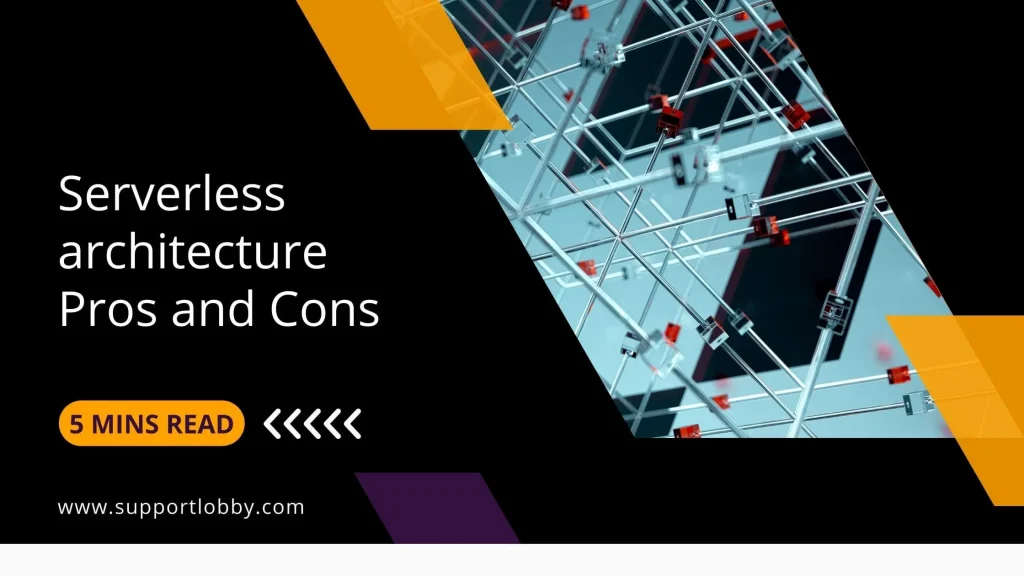What’s Serverless Architecture – Key Benefits and limitations

Overview Of Serverless Technology
Serverless architecture and serverless computing are some of the latest technical jargon. Serverless architecture is an alternative strategy that tends to do away with traditional server management strategies. Serverless architecture helps teams to dedicate their time and energy to application development rather than spending it on server management. Serverless architecture makes it possible to develop products without having to bother about the management of infrastructure, scaling, provisioning, etc.
This can also do away with server management intricacies like maintaining uptime, ensuring safe upkeep, and maintenance of the hardware components. So, in a nutshell, the serverless model enables you to develop applications without having to invest or manage the infrastructure. A survey by O’Reilly revealed that about 40 percent of enterprises have moved to serverless models. So the many reasons that attribute to it are lower expenditure, scalability, no overhead associated with server maintenance, better turnaround time, etc. You don’t have to worry about purchasing or maintenance of standby and backend servers.
Depending on the architecture serverless technology can be grouped into two models
1)Back-End as a Service or BaaS
BaaS enables enterprises to focus fully on front-end application development. BaaS providers enable you to leverage advantages by providing Application Programming Interfaces (API). BaaS services include client applications like mobile apps or web apps.
2)Function as a Service or FaaS
FaaS is also known as Compute as a Service (CaaS). FaaS services are managed by a third party and run in stateless compute containers that are event-triggered. When certain events happen in modules, functions are automatically triggered. The development team writes code that triggers function execution. The service provider executes the code and the processed result is available to the end-users via a web application. It has better efficiency as resources are automatically scaled.
Use Cases of Serverless Technology
Some of the popular examples and use cases of serverless technology are the soft drink giant Coca-Cola and waste management solutions company GreenQ. According to Appdynamics, soft drink giant Coca-Cola could save significantly due to the implementation of serverless technology in their vending machines. As per Appdynamics, the auto-scaling available through serverless technology could assist GreenQ to tackle the variations in infrastructure demands.
Advantages of Serverless Architecture
Serverless architecture offers you a number of benefits. These include
1) No Explicit Server Management
This is the prime advantage of using serverless architecture. It allows your team to focus on the core development process. You need to worry about monitoring and management of servers. Configuration and security will be handled by the vendor. Serverless architecture can enable you to better create and expand the applications and the server capacity will be no longer a constraint.
2) Reduced Costs
Moving towards serverless architecture can greatly reduce your expenses. Serverless computing takes up less power and human resources. You need not build, monitor, and control them. You need to take care of the server-side code only and the infrastructure is automatically taken care of by the serverless architecture. Here also responsibilities with respect to managing servers, databases, etc are usually outsourced.
3) Scalability
Serverless architectures are highly scalable. As the usage increases serverless infrastructure scales automatically. Serverless architecture can thereby handle a large number of requests, unlike the conventional system which is usually constrained in terms of space and cannot handle a large surge in users. With serverless architecture, your applications can be subjected to periodic changes as it grows. The scaling is automatic and you only need to pay for what you use.
4) Green Initiative
Serverless architectures give you the provision to buy servers based on requirements. Enterprises deploying their own data centers are constrained by factors like space and energy. The physical resources and the associated infrastructure requirements are huge apart from the energy required to maintain and run them. Serverless technology can indeed cut down your energy requirements.
Disadvantages of Serverless Architecture
Serverless architectures are still a concern for many as it is not fully evolved and established. Some of the limitations of this architecture include.
1) Limitations in Security
Serverless providers may be running code on a single server for multiple customers at a given time. This ‘multitenancy’ can affect performance and could result in data breaches if these are not properly configured. Security will be a concern for applications that handle sensitive data as the entire backend is run by the vendor and it is difficult to monitor the security.
2) Performance Issues
Serverless architecture has an overhead associated with initiating internal resources and this usually results in a ‘cold start’. The start time may also degrade the performance as the code needs to be booted up. In order to avoid a ‘cold start’, the code that is to be run periodically should be kept in an active state.
3) Overdependence on the Vendor
All the backend services are provided by the vendor and hence changes may go unnoticed. The overreliance on vendors for services and vendor switching is a concern as far as serverless architectures are concerned.
Conclusion
Serverless technology is very much recommended for small functions that need to be hosted. Over time you can move your applications one by one to serverless technology. A surge in data indeed enables serverless technology to be adopted as a viable option to offload functions. By offering lower costs and time to market, serverless technology is indeed poised to grow further.
Activelobby provides web hosting support services. We provide 24-by-7 server hosting management services. We have managed over three lakh websites and applications. We monitor your services proactively every minute and troubleshoot or restart the disrupted services within the frame limits of the Service Level Agreement (SLA).
Our Team use best-in-class tools like cPanel, Plesk, Virtuozzo, Proxmox, Citrix, etc for web hosting support services. Activelobby also offers web hosting migration support and services. Our team monitors your current server infrastructure and assists you in preparing a migration roadmap. We can execute the migration process with minimum downtime as our engineers adhere to the best industry-proven practices.
Activelobby has post-migration support services to ensure that you get acquainted with the system and learn how to effectively manage it on your own. Though we recommend using the control panel for servers so that it can facilitate easy administration, we also support servers that do not have a control panel.
We had accomplished cPanel to DirectAdmin migration for one of our clients who is one of the top five web solution companies in India. We offer support services through chats, helpdesk management, phone, etc
